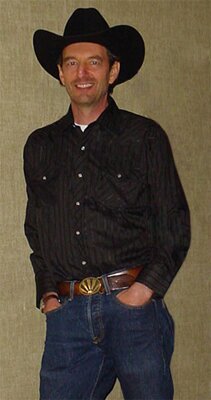Welcome to the “My Place” page
 My name is Scott My name is Scott
I run the Rope and Wire website.
My original idea for this page was to give those living in the country the opportunity to tell others about the things that made their farm or ranch so special.
Well, I’ve come to the conclusion that either no one likes to brag or no one lives on a farm or a ranch. Whatever the case, no one submitted an article so I felt it was high time to try something different.
So for now this will be literally “My Place.” I’ll use this page to post a western blog or short articles. They will either be mine, or possibly one from a contributing R&W community member.
The theme will remain Western but the content will change weekly, or there about.
If you click on any of the links to past blog's, you can return to this page by clicking on the My Place button across from my picture.
I hope you enjoy it but if not, might I suggest you “stroll the grounds.” Read a story or watch a movie.
Thanks for visiting.
Scott
Monument Valley
Monument Valley is considered to be the most famous landscape in the American Southwest. It provides one of the most enduring and definitive images of the American West.
The valley has been the setting for many western films and television commercials. In fact, more western movies have been filmed at Monument Valley than any other location in the United States.
Located in northeastern Arizona and southeastern Utah, Monument Valley encompasses approximately 2,000 square miles of vast, open desert and lies entirely within the 16 million acre Navajo Indian Nation. The Navajos have occupied the valley since the 1860s.
Monument Valley is part of the Colorado Plateau where at one point in time a regional uplift occurred. This upward pressure from below broke and cracked the landscape. Though most of the breaking occurred underground the effects of time and erosion eventually revealed the isolated red mesas, tall red sandstone buttes, freestanding rock formations, arches and canyons that characterize the unique landscape we see today.
The mesas of Monument Valley didn’t start out as such. It was a gradual emergence, when a succession of hard and soft layers of earth were cut into by a river or brought up by a fault.
Over time, mesas themselves break down, becoming a butte, then a spire like the valleys well known “Totem Pole”, and eventually it disappears altogether. Monument Valley is an excellent example of this timeless disintegration process.
At first glance, Monument Valley may appear as a dusty, dry, barren desert, and for the most part, that’s exactly what it is, dusty and dry. But barren, that would hardly be the case. The abundant rustic landscape itself is the prominent feature that gives this valley its unparalleled beauty and notoriety.
Over the years, Monument Valley has become a major symbol of the open spaces and rugged landscape that can be found in the American West.
The following photo of Monument Valley was sent to me by one of Rope and Wires community members, Pat Gott.
This is her posing on her horse.
 |
|